CDL Practice Tests: Flatbed Cargo Securement
Choose A Section:
Go!When securing a non-cubic boulder with an unstable base, the four surrounding chains must have a WLL of at least:
- 50% the weight of the boulder
- 11,000 lbs
- 25% the weight of the boulder
- 5,000 lbs
Special Circumstances: Securing a Non-Cubic Shaped Boulder with an Unstable Base
The securement of a non-cubic shaped boulder with an unstable base must meet these requirements in addition to the other large boulder requirements in Section 13.
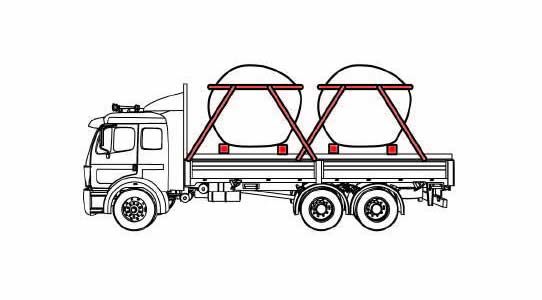
Surround the top of each boulder at a point between 1/2 and 2/3 of its height with one chain.
The WLL of the chain must be at least 50% of the weight of the boulder.
Attach four chains to the surrounding chain and the vehicle to form a blocking mechanism that prevents any horizontal movement.
Each chain must have a WLL of at least 25% the weight of the boulder, and the angle of the chain must be less than 45░ from the horizontal.
Within the requirements for concrete pipe, which of these requires specific securement methods?
- Concrete pipe that is grouped together into a single rigid article and may not roll.
- Concrete pipe eyes vertical and concrete pipe loaded lengthwise.
- Concrete pipe loaded in a sided vehicle or container.
- Concrete pipe loaded cross-wise on a flatbed trailer.
What is exempt from these specific requirements?
Follow general cargo securement requirements (Section 2) when transporting the following pipe:
- Concrete pipe that is grouped together into a single rigid article and may not roll.
- Concrete pipe loaded in a sided vehicle or container.
- Concrete pipe eyes vertical and concrete pipe loaded lengthwise.
What is covered under these specific requirements?
Any concrete pipe loaded crosswise on a platform trailer or vehicle that is not exempt.
A chock is defined as:
- A structure, device, or another substantial article placed against or around an article to prevent horizontal movement of the article.
- A short piece of material, usually wood, nailed to the deck to reinforce blocking.
- A tapered or wedge-shaped piece used to secure round articles against rolling.
- A crosswise load bearing structural component, particularly a part of a log bunk.
Chock:
A tapered or wedge-shaped piece used to secure round articles against rolling.
Working Load Limit (WLL)is defined as:
- The summation of the working load limits or restraining capacity of all devices used to secure an article on a vehicle.
- The acceleration due to gravity, 9.823 m/sec2 (32.2 ft/sec2).
- The maximum load that may be applied to a component of a cargo securement system during normal service, usually assigned by the manufacturer of the component.
- The number of hours that a tiedown can be used.
Working Load Limit (WLL):
The maximum load that may be applied to a component of a cargo securement system during normal service, usually assigned by the manufacturer of the component.
When securing flattened or crushed cars on a vehicle with containment on 2 sides, how many tiedowns, at minimum, are required?
- 2
- 3
- 4
- 1
Option 3:
Has containment walls on two sides that:
- Extend to the full height of the load.
- Block against cargo movement in the forward and rearward.
Secures each stack of vehicles with a minimum of three tiedowns, each having a minimum WLL of 2,268 kg (5,000 lb.).
Which of the following is not a requirement of wood used as blocking or bracing?
- Hardwood is recommended.
- It should be properly seasoned.
- It should be free of decay and structural defects.
- It should be painted.
If wood is used:
- Hardwood is recommended.
- It should be properly seasoned.
- It should be free from rot or decay, knots, knotholes, and splits.
When loading and securing a boulder, it should be:
- All of these are requirements.
- Supported on at least 2 pieces of 4in x 4in hardwood blocking, extending the full width of the boulder.
- Placed on symmetrical hardwood blocking that extends 3/4 of the length of the boulder.
- Placed on the vehicle with its largest or flattest side down.
Requirements
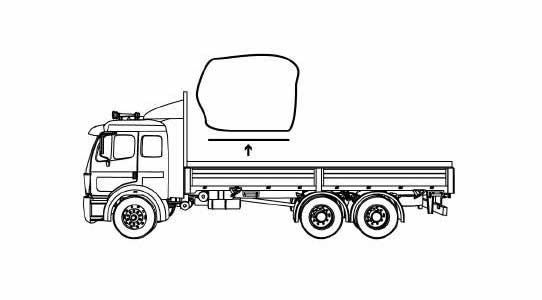
Place each boulder on the vehicle with its flattest and/or largest side down.
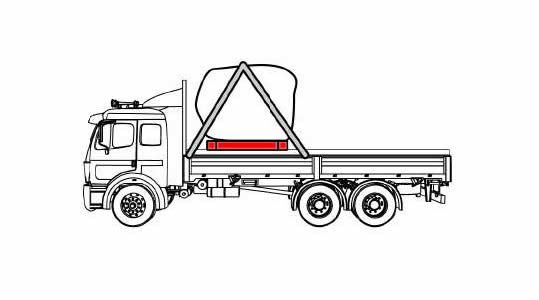
Support each boulder on at least two pieces of hardwood blocking (at least 10 cm x 10 cm (4 x 4 in) that extend the full width of the boulder.
Place hardwood blocking pieces as symmetrically as possible under the boulder so they support at least 3/4 of the length of the boulder.
An intermodal container is:
- A reusable, transportable enclosure that is especially designed with integral locking devices that secure it to a container chassis trailer to facilitate the efficient and bulk shipping and transfer of goods by, or between various modes of transport, such as highway, rail, sea, and air.
- A vehicle especially built and fitted with locking devices for transport.
- A specialized container, primarily used to contain and transport materials in the waste, recycling, construction/demolition, and scrap industries, which are used in conjunction with specialized vehicles, in which the container isloaded and unloaded onto a tilt frame body by an articulating hook-arm.
- A platform or tray on which cargo is placed so that it can be handled as an article. (Same as "Skid")
Intermodal Container:
A reusable, transportable enclosure that is especially designed with integral locking devices that secure it to a container chassis trailer to facilitate the efficient and bulk shipping and transfer of goods by, or between various modes of transport, such as highway, rail, sea, and air.
Who is responsible for inspecting securing devices and cargo within the first 50 miles?
- Your Moms.
- The D.O.T.
- The shipper.
- The driver.
Inspect Cargo and Securing devices:
- Pre-Trip: Yes
- Within first 50 mi: Yes
- When duty status of driver changes: Yes
- At 3 hour intervals or every 150 mi, whichever is first: Yes
When securing a single metal coil with eyes vertical:
- Attach at least one tiedown over eye of coil from side-to-side.
- Attach at least one tiedown diagonally across eye of coil from left side of vehicle to right side of vehicle.
- These are all requirements.
- Attach at least one tiedown diagonally across eye of coil from right side of vehicle to left side of vehicle.
To prevent the coil from tipping forward, rearward, and sideways, arrange tiedowns to include the following:
- Attach at least one tiedown diagonally across eye of coil from left side of vehicle to right side of vehicle.
- Attach at least one tiedown diagonally across eye of coil from right side of vehicle to left side of vehicle.
- Attach at least one tiedown over eye of coil from side-to-side.
About The Flatbed Cargo Securement CDL Manual
Studying the flatbed cargo securement CDL manual is not a requirement for getting your CDL permit or license. It is required knowledge for flatbed drivers.
Some questions you should be able to answer for flatbed cargo securement:
- What is the minimum Working Load Limit of a tiedown used to secure logs?
- What is the minimum weight of a shipment of paper rolls that would require specific securement requirements?
- When securing concrete pipe over 45 inches loaded crosswise, which direction must the tiedowns on the front half of the load run?
- What is a cab shield?
- When securing concrete pipe over 45 inches loaded crosswise, which direction must the tiedowns on the rear half of the load run?
- What is a dunnage bag?
- Who is responsible for inspecting securing devices and cargo within the first 50 miles?
- How many tiedowns are required on a stack of shortwood loaded crosswise?
- What is the minimum working load limit of each tiedown used to secure crushed or flattened vehicles?
- Define 'bolster'
- What is a hook-lift container?
- When a tiedown is attached directly to the cargo, what is the ideal angle where it attached to the vehicle?
What is a securing device?
Any device specifically manufactured to attach or secure cargo to a vehicle or trailer:
- Synthetic Webbing
- Chain
- Wire rope
- Manila rope
- Synthetic rope
- Steel strapping
- Clamps and latches
- Blocking
- Front-end structure
- Grab hooks
- Binders
- Shackles
- Winches
- Stake pockets
- D-rings
- Webbing ratchet
- Bracing
- Friction mat
What is a tiedown?
A combination of securing devices that forms an assembly that:
- Attaches cargo to, or restrains cargo on a vehicle.
- Is attached to anchor point(s).
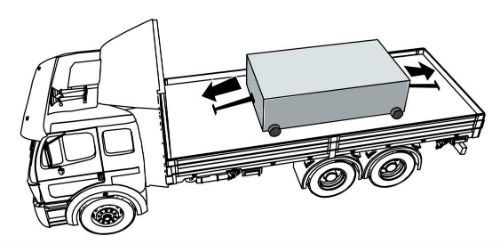
Some tiedowns are attached to the cargo and provide direct resistance to restrain the cargo from movement.
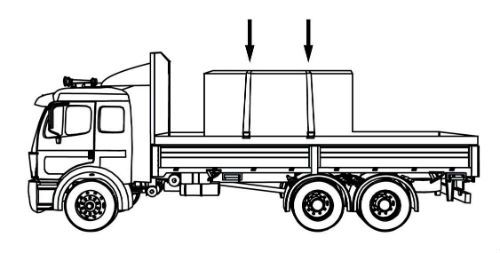
Some tie-downs pass over or through the cargo. They create a downward force that increases the effect of friction between the cargo and the deck. This friction restrains the cargo.
 Related Cargo Securement Terms That Every Driver Should Know:
Related Cargo Securement Terms That Every Driver Should Know:
-
Tiedown:
A combination of securing devices which form an assembly that attaches cargo to, or restrains cargo on, a vehicle or trailer, and is attached to anchor point(s).
-
Contained:
Cargo is contained if it fills a sided vehicle, and every article is in contact with or sufficiently close to a wall or other articles so that it cannot shift or tip if those other articles are also unable to shift or tip.
-
Blocking:
A structure, device, or another substantial article placed against or around an article to prevent horizontal movement of the article.
How should tiedowns be attached?
Tiedowns can be used in two ways:
-
Attached to the cargo:
- Tiedowns attached to the vehicle and attached to the cargo.
- Tiedowns attached to the vehicle, pass through or aroundan article of cargo, and then are attached to the vehicle again.
-
Pass over the cargo:
- Tiedowns attached to the vehicle, passed over the cargo, and then attached to the vehicle again.
Tiedown placement:

Place the tiedown as close as possible to the spacer.
Position the tiedowns as symetrically as possible over the length of the article.

Position the tiedowns to preserve the integrity of the article.







 TT On Facebook
TT On Facebook